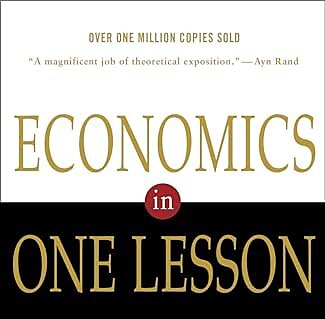Henry Hazlitt died 32 years ago this week, but his economic insights remain stubbornly relevant. His 1946 classic, Economics in One Lesson, has sold more than a million copies and continues to attract readers with its clarity, logic, and unapologetic defense of capitalism. While many economists have tackled the myths of interventionist policies, few have done so with Hazlitt’s lucidity—or persistence. Nearly eight decades later, the very fallacies Hazlitt debunked are not only alive but thriving in today’s policy debates.
From tariffs to rent control, minimum wage laws to corporate subsidies, Hazlitt laid bare the unintended consequences of government meddling. Drawing deeply from Frederic Bastiat’s concept of the “seen and unseen” and Ludwig von Mises’s Austrian tradition, Hazlitt reminded readers that political proposals are often judged only by their immediate, visible effects on a special group—not by their long-term, economy-wide costs to all groups. He called this the “fallacy of overlooking secondary consequences.” That lesson still hasn’t sunk in.
Take the minimum wage, for example. Last month, Senators Josh Hawley (R‑MO) and Peter Welch (D‑VT) introduced legislation to raise the federal minimum wage to $15 an hour, with automatic inflation adjustments. Vice President JD Vance favors an $11 rate. In New York City, mayoral candidate Zohran Mamdani, a self-declared socialist, wants a $30 minimum wage for the city. According to Welch, “Every hardworking American deserves a living wage.”
But as Hazlitt explained nearly 80 years ago, that kind of economic paternalism ignores reality. A wage is not a moral declaration—it is a price. Raise the price, and demand falls. When wages are mandated above the productivity level of the worker, employers have limited options: lay off staff, cut hours, reduce hiring, or replace workers with machines. Hazlitt’s summary still holds: “For a low wage you substitute unemployment. You do harm all around, with no comparable compensation.”
We are watching this play out in real time. California’s recent $20-an-hour mandate for fast food workers has already triggered substantial job losses and menu price hikes. Hazlitt saw it coming and explained it clearly. But some lawmakers today are still struggling with the issue.
Rent control is another case of economic denialism. From New York to California to Oregon, many cities continue to impose price ceilings on rent in an attempt to protect tenants. NYC’s Mamdani has pledged to freeze rents for approximately two million rent-stabilized apartments. The problem? Rent control doesn’t create affordability—it destroys supply. Hazlitt called it a textbook example of price distortion: when you hold rents artificially low, demand surges, supply stalls, maintenance declines, and slums multiply. “The majority of tenants,” Hazlitt warned, “in whose supposed interest the rent control was imposed in the first place, become worse off than ever.”
Rent control distorts the housing industry; it is the result of government intervention in the marketplace. “So we come back to your basic lesson,” Hazlitt says. “The pressure for rent control comes from those who consider only imagined short-run benefits to one group in the population. But when we consider its long-run effects on everybody, including the tenants themselves, we recognize that rent control is not only increasingly futile, but increasingly destructive ….”
Another economic fallacy in the news today is that technology and automation, including artificial intelligence (AI), will on net balance create mass unemployment. “What I am not willing to see are large amounts of jobs or really any number of good-paying jobs ruined, destroyed, taken by AI,” said Senator Josh Hawley (R‑MO). Former Labor Secretary Robert Reich warned that “the rush to automate is creating a crisis of unemployment and inequality.”
But the data tell a different story. As of June, the national unemployment rate stood at 4.1 percent, well within historic norms despite many years of automation growth and budding AI. No doubt, AI is putting some people out of work and possibly will take a heavy toll over time, but, as Hazlitt explained, new technological advances reduce costs, boost productivity, and create new kinds of work. Think of how the automobile replaced the horse or the PC replaced the typewriter.
Indeed, if employment were our sole goal, we could ban trucks and planes and hire millions of people to haul freight on foot, said Hazlitt.
These are just three of the fallacies Hazlitt dismantled. In Economics in One Lesson, he takes on 22 others, ranging from inflation and deficit spending to public works and credit expansion. His great strength wasn’t just his grasp of theory—it was his ability to translate economic principles into common sense. Hazlitt’s overall lesson was simple: policies must be evaluated not just by their immediate effects on a single group, but by their long-term consequences for everyone.
F.A. Hayek praised Economics in One Lesson as unparalleled in teaching lay readers the economic basics. H.L. Mencken called Hazlitt “one of the few economists in human history who could really write.” Ludwig von Mises, at Hazlitt’s 70th birthday, told him, “You have demonstrated again that the economic policy recommended by the liberal economists of the nineteenth century is the only policy fit to improve the material conditions of all the people. … One has to repeat this truth again and again because, as an eminent author once said, the liars are repeating again and again their lies.”
In an age where economic fallacies continue to shape legislation and dominate headlines, Hazlitt’s clarity is more vital than ever. It is not enough to expose flawed ideas. As Hazlitt himself wrote, advocates of free markets, limited government, and individual liberty must keep repeating the fundamentals “over and over again.”
After all, the economic nonsense won’t go away on its own.
















